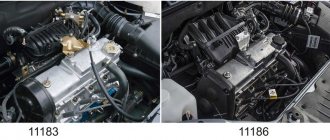The fuel consumption of Lada Largus depends on the engine used, road or climatic conditions, as well as the weight of the cargo being transported. When operating the car in urban conditions and on the highway, the parameter differs from the factory values by 5-10% upward. With a further increase in fuel costs, it is necessary to check the technical condition of the engine and gasoline supply and exhaust gas systems.
fuel consumption of Lada Largus on the highway
Gasoline consumption of Lada Largus according to the passport
All owners of a Lada Largus car have the same fuel consumption data in their registration certificate. They were determined at the testing stage during vehicle production. In this case, certain standard conditions were observed and only special equipment was used. During the measurement procedure, the requirements of state standards were observed.
As a result, the fuel consumption of the Lada Largus in the city is:
- for the station wagon - 10.1 liters (16 valves) and 10.6 liters (8 valves);
- for the van body - 10.4 liters (16 valves) and 10.6 liters (8 valves).
At the same time, on the highway, the gasoline consumption of the Lada Largus per 100 km will differ. In the case of a station wagon (16 and 8 valves) and a van (8 valves), this figure is 6.7 liters. For a van with 16 valves, the consumption is less - 6.4 liters.
Another consumption calculation is shown for mixed driving. For both body types with the K4M engine it is 7.9 liters; for the 11189 engine it does not exceed 8.2 liters.
Real fuel consumption figures
Despite the large volume of clinical tests that all cars undergo before being placed on the market, the gasoline consumption of the Lada Largus presented in the technical data sheet may differ significantly from the actual figures. They can be influenced by various factors, both external and internal, so each owner of such a vehicle may have his own numbers.
Lada Largus 1.6 and 84 l with
The smallest engine can produce 84 horsepower. The maximum speed it can reach does not exceed 155 km/h. At the same time, the cylinder volume is 1.6 liters. It has only 8 valves, so it is considered the least powerful.
In the city, the consumption of the Lada Largus 1.6 is 12.3 liters, on the highway no more than 7.2 liters, and in mixed driving 7.5 liters.
If you calculate the indicators for a cargo or passenger type body, the data will be almost identical. A station wagon requires the least amount of fuel.
Lada Largus 1.6 and 90 l with
For cars with a 90 horsepower engine, despite similar technical characteristics to the previous model, the consumption will be different. In practice it amounts to:
- highway - 7.0 liters;
- city - 12.4 liters;
- mixed type - 7.7 liters.
Thus, even with a more powerful engine, for indicators such as the highway, a savings of 200 grams is noticeable.
Lada Largus 1.6 and 105 l with
The most powerful model has 105 horsepower and 16 valves under its hood. This makes it possible to accumulate a small reserve of power for critical circumstances. At the same time, the acceleration occurs more confidently and quickly.
Initially, the Renault Espana plant was engaged in the production of such engines, but today its production has been transferred to AvtoVAZ. Due to the introduction of EURO-5 standards, the vehicle's power was significantly reduced from 105 to 102 horsepower. The reduction also affected torque. This figure is 145 Nm.
Standard • Engine 16l 106l 21129
I bought a 2011 car, just off the assembly line, and I don’t regret anything, parts are always available in any store, although breakdowns do not happen often if the main components are serviced in a timely manner. Just like the previous power unit, this engine is paired with a 5-speed manual gearbox and can accelerate the car to a maximum speed of 155 km/h.
| № | Positive |
| 1 | Andrey (Avtodrom): I’ve been driving carefully for three years now and systematically carry out maintenance. I heard about the valve problem. I think that a lot depends on the driver. |
| 2 | Sergey (Avtotema): I have a 16-valve engine, the pickup from the bottom is weak, but on the highway the engine is a “beast”, I have no complaints about the internal combustion engine, I’m happy with the purchase. |
| 3 | Kirill (Autoreview): the engine has driven 65,000 km and is normal; at every service I carry out diagnostics. |
| 4 | Alexey (Avtoria): unlike Granta, Vesta is more powerful, with a good pick-up. I'm glad for the domestic manufacturer. |
| 5 | Alexander (Drom): my positive review of the VAZ 21116, four years of active use without any comments. |
| 6 | Stanislav (Driving): I have no problems with the car, the mechanisms are working normally. |
| 7 | Vasily Alekseevich (“5th wheel”): at 50,000 km the alternator belt began to whistle, tightened it. The valves do not knock, the engine runs smoothly. |
| Negative | |
| 8 | Vitaly (Avtotema): recently the belt drive broke, fortunately it reacted with lightning speed, the valves were not damaged. |
| 9 | Svyatoslav (Otzovik.net): when they broke, the first and third pistons were deformed, replaced them with new ones. The repairs weren't cheap. |
| 10 | Vlad (ProAuto): I regret that I bought Vesta with a domestic engine, my comrades advised me to buy it with a Renault engine. |
About reducing fuel consumption during the running-in process
When measuring fuel consumption, the manufacturer uses new cars and a certain type of route. However, as the mileage increases, the amount of fuel required per 100 kilometers changes. Most often, a more economical situation is noted.
So, for example, for a range of up to 30,000 kilometers, the rate of fuel consumption for every 100 kilometers is 9.3 liters. If we take the same route, but the car’s mileage will be twice as long (60,000 kilometers), then the consumption rate will decrease and will be 8.3 liters. Such figures make it possible to determine at what point the vehicle's running-in was completed.
Thus, at this stage, fuel consumption, regardless of the type of body (station wagon, van), will always be higher than after the end of the run-in.
Cooling system
The motor is equipped with a forced-type liquid cooling system. Cooling of the liquid is carried out in the radiator. The movement of coolant in the radiator and cooling jacket is carried out using a water pump. It is belt driven from the crankshaft of the power unit.
For quick warm-up in the cold season, a thermostat is included in the cooling system. At low coolant temperatures, the thermostat closes a large circulation circle. This allows for rapid heating of the coolant. Once the required temperature is reached, the thermostat opens a large circle.
What determines actual gasoline consumption?
If the fuel consumption standards for a vehicle depend on the technical characteristics of the model (engine power, number of valves, cylinder volume), then the actual consumption is related to:
- Low quality fuel. Since at many gas stations special additives are added to gasoline to increase the octane number, traffic movement may become difficult, which causes an increase in consumption.
- A large number of electrical equipment in active mode. Since the operation of such elements requires energy, they actively take it away from the car, which also affects the increase in consumption. Moreover, this happens not only in Lada models, but also in any other brand.
- Engine heating. During the winter, a large share of gasoline is spent on these needs.
- Production of engine parts. The presence of problems in the fuel, exhaust, or cooling systems has a direct impact on fuel consumption, significantly increasing it. One of the signs of such a problem is the changed color of the exhaust gases.
- The terrain. While the driver may not visually notice a small hill, the car feels every bump. If the load increases with ascent, then the volume of fuel consumed changes accordingly, and vice versa, if the car is driving on a descent, then this indicator decreases.
- Weather conditions. With a strong tailwind, the car receives a small level of deceleration, so to eliminate it it is necessary to apply a greater load, as a result of which gas mileage changes. When driving in the rain, the car also spends more energy due to an increase in the rolling resistance of the tires, which also affects the amount of fuel consumed.
- Workload. Each passenger increases the weight of the vehicle, and therefore the gasoline consumption by several percent.
- The driver's driving style. With a sharp start and braking, the level of fuel consumed increases. On the contrary, during smooth movements with coasting, it decreases.
At the same time, another factor that increases the required amount of fuel is driving with the windows open. In this position they increase aerodynamic drag. As a result, the Largus model consumes 100-500 grams of gasoline more.
Fuel consumption on the highway
To determine a more accurate indicator of fuel consumption, it is necessary to consider traffic within the city and on the highway. In the second cycle, this figure will always be less, since the vehicle’s movement is smooth and stable. Most often, when driving in suburban areas, they stick to maintaining the same speed.
For Lada Largus cars, real gasoline consumption outside the city is 6.7 -7.2 liters per 100 kilometers; according to technical documentation, it is in the range of 6.4 - 6.7 liters per 100 kilometers.
Fuel consumption in urban conditions
In the urban cycle, you should be prepared for higher fuel consumption. This is affected by increased traffic intensity associated with traffic lights, frequent accelerations and stops, parking with the engine running, etc. As a result, according to reviews from car owners, the real fuel consumption in the urban cycle for the Lada Largus model is 11.8 - 12.4 liters per 100 kilometers.
The actual volume of fuel consumed by a car is determined individually, since it depends on a large number of factors. However, in rare situations, this indicator corresponds to the information specified in the technical documentation of the car. The actual consumption can only be determined independently.
Source
New generation Lada
The presentation of Lada Largus, which is a joint project of VAZ and Renault, took place in 2011. The purpose of inventing this version of the Lada was to make the 2006 Dacia Logan similar to the Romanian car, suitable for Russian roads.
| Model | Consumption (highway) | Consumption (city) | Consumption (mixed cycle) |
| Lada Largus | 6.7 l/100 km | 10.6 l/100 km | 8.2 l/100 km |
Technical characteristics of the Lada Largus, fuel consumption and maximum speed for all models are almost the same
. The main configuration parameters include:
- Front-wheel drive;
- 1.6 liter engine;
- 5-speed manual transmission;
- The fuel used is gasoline;
Each car has an 8- and 16-valve engine, except for the Cross version. It is equipped only with a 16-valve engine. The maximum speed of the car is 156 km/h (with engine power of 84, 87 horsepower) and 165 km/h (engine with 102 and 105 horsepower). Acceleration to 100 kilometers is carried out in 14.5 and 13.5 seconds, respectively. The average fuel consumption of Largus per 100 km in the combined cycle is 8 liters.
Tuning the Largus engine and other models with engine 21129: Engine 16l 106ls 21129
| Consumption table for VAZ engines As for fuel consumption, I can say that gasoline consumption is acceptable, of course the car consumes a lot at high speeds, but on the highway everything changes for the better. Below we present the characteristics of the most popular models, and in the tables below them the average fuel consumption of a Lada car per 100 km is based on A-95 gasoline, the unit of measurement is liter when driving in the urban cycle, outside the city and in the mixed cycle. |
- K7M - 8-valve engine with 84 hp. pp., which is produced at the Automobile Dacia plant (Romania) of the Renault concern.
- K4M - 16-valve power unit with a capacity of 105 hp. pp., manufactured at the Renault Espana plant; The K4M power unit is also assembled at AvtoVAZ OJSC. In terms of ecology, it now complies with EURO-5 standards, but at the same time it has lost a little in power (102 hp) and torque (145 Nm).
- VAZ-11189 is a domestic 8-valve engine with a power of 87 hp. With.
Fuel costs.
Fuel consumption varies for each Largus model. And the Ministry of Transport calculates the indicators relative to the standard fuel consumption for the Lada Largus under ideal driving conditions. Therefore, official data often differs from real figures.
Fuel consumption for 8-valve models
Engines of this type include cars with engine power of 84 and 87 horsepower. According to official statistics, gasoline consumption on the 8-valve Lada Largus is 10.6 liters in the city, 6.7 liters on the highway and 8.2 liters with mixed driving.
The actual figures for gasoline costs look a little different.
A review of numerous reviews from the owners of this car has the following results: city driving consumes 12.5 liters, country driving about 8 liters and in the combined cycle - 10 liters.
Winter driving increases fuel consumption, especially in severe frosts, and it increases by an average of 2 liters.
Advantages and disadvantages
- Saving fuel and lubricants. The 21129 engine has low fuel and lubricant consumption. Such indicators were achieved thanks to the new firmware;
- Increased power. The maximum engine power is 106 horsepower. When tuning, it is possible to increase this figure;
- Compliance with European environmental standards. More complete combustion of fuel in the chamber allows not only to improve technical performance, but also to increase the environmental class to the Euro 5 standard;
- Improved additional equipment. The manufacturer installed a modernized DC generator and improved mounting pads on the engine of the Lada X-ray and other models;
- Reliability and service life of the engine 21129. The manufacturer declared the service life of the power plant to be 200,000 km.
- When the belt breaks, the piston, moving to top dead center, bends the open valves;
- High cost of communication maintenance and repair due to the presence of expensive foreign-made parts;
- Poor quality of the cooling system thermostat. The engine takes a long time to warm up in the winter;
- The need to use high-quality fuel and expensive lubricants.
Factors increasing gasoline costs
The main reasons for consuming more fuel are:
- Engine fuel consumption often increases due to low-quality fuel. This happens if you had to use the services of unverified gas stations or “filling up” with gasoline with a lower octane number.
- An important point is the use of additional electrical equipment or unnecessary track lighting. They promote the combustion of large quantities of gasoline in a short time.
- The driving style of the car owner is considered the main factor that affects the gasoline consumption of Lada Largus of all models. To avoid such problems, you need to drive smoothly and brake slowly.
Reviews from car owners
Thus, the car on different sections of the highway moves at different speeds from 40 to 130 km per hour, and the average speed of a car such as LADA Largus does not exceed 77 km per hour. Fuel consumption in any car depends on a number of subjective and objective factors, ranging from traffic congestion, the number of traffic lights along the way and the time of year, to driving style.
Lada Largus Cross
A new, modernized version of the Lada Largus was released in 2014. According to many car enthusiasts, this model is considered the Russian prototype of an SUV. And some technical characteristics and equipment contribute to this.
The basic fuel consumption rate of the Lada Largus on the highway is 7.5 liters, city driving “consumes” 11.5 liters, and mixed driving – 9 liters per 100 km. Regarding gasoline consumption in reality, real fuel consumption at Largus Cross increases by an average of 1-1.5 liters
Source
How are regulations regulated?
A vehicle requires fuel to operate. Each category of car requires different volumes of fuel and lubricants. The Ministry of Transport has developed a special standard - this is the fuel consumption rate for car brands. The standard allows you to determine how much fuel and lubricants a specific brand of vehicle requires to support the technological process.
The Ministry of Transport introduced the standards by a separate Order dated March 14, 2008 No. AM-23-r (as amended on September 20, 2020). The document establishes several categories of standards for fuel and fuel consumption:
- Basic standard for gasoline consumption in liters per 100 km in running order.
- Transport standard in liters per 100 km in operation (during transport work), including:
- cost standard for a bus taking into account curb weight and nominal passenger load;
- consumption standard for dump trucks, taking into account equipment and nominal vehicle load.
- Transport standard for a truck in liters per 100 ton-kilometers, determined during transport work.
Standards are set in liters, for example, for gasoline or diesel fuel. Or the standards are fixed in cubic meters if, for example, transport consumes gas.
New Lada: Garant Bastion anti-theft ignition switch for Lada, Renault, Nissan











